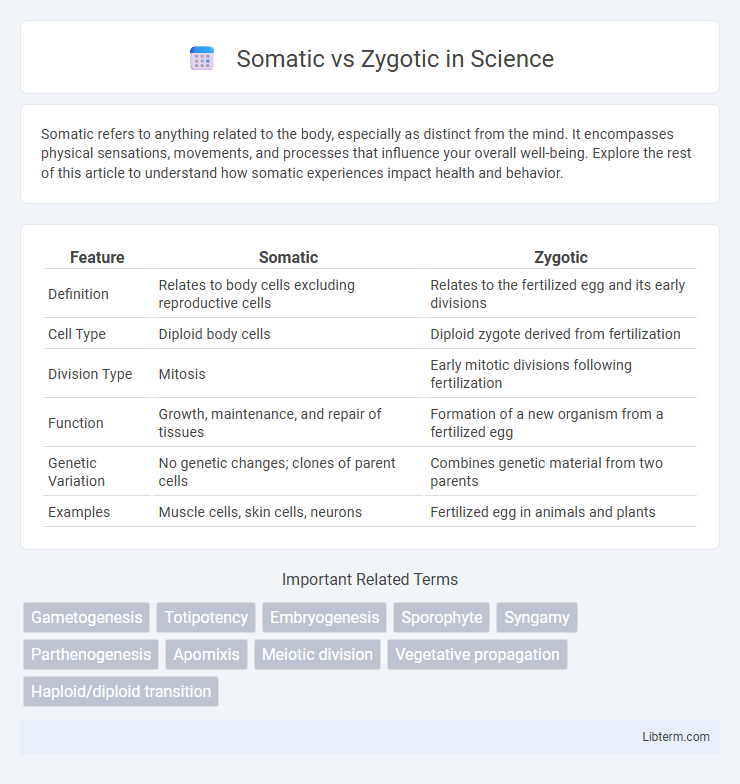Somatic refers to anything related to the body, especially as distinct from the mind. It encompasses physical sensations, movements, and processes that influence your overall well-being. Explore the rest of this article to understand how somatic experiences impact health and behavior.
Table of Comparison
| Feature | Somatic | Zygotic |
|---|---|---|
| Definition | Relates to body cells excluding reproductive cells | Relates to the fertilized egg and its early divisions |
| Cell Type | Diploid body cells | Diploid zygote derived from fertilization |
| Division Type | Mitosis | Early mitotic divisions following fertilization |
| Function | Growth, maintenance, and repair of tissues | Formation of a new organism from a fertilized egg |
| Genetic Variation | No genetic changes; clones of parent cells | Combines genetic material from two parents |
| Examples | Muscle cells, skin cells, neurons | Fertilized egg in animals and plants |
Introduction to Somatic and Zygotic Concepts
Somatic cells constitute the body's non-reproductive cells, responsible for forming tissues and organs through mitotic division, maintaining genetic consistency across cell generations. Zygotic cells originate from the fusion of gametes during fertilization, representing the initial totipotent cell that undergoes mitotic divisions to develop into a multicellular organism. Understanding the distinction between somatic and zygotic cells is crucial for studies in developmental biology and genetics.
Defining Somatic Cells
Somatic cells are diploid cells forming the body tissues and organs in multicellular organisms, excluding reproductive cells. These cells undergo mitotic division to enable growth, repair, and cellular replacement, maintaining genetic consistency throughout the organism. Unlike zygotic cells, which arise from fertilization and give rise to gametes through meiosis, somatic cells cannot contribute to offspring genetically.
Understanding Zygotic Cells
Zygotic cells originate from the fusion of male and female gametes during fertilization, marking the start of a new organism's development. These cells are totipotent, possessing the ability to differentiate into all cell types necessary for forming the entire body and extraembryonic tissues. Understanding zygotic cells is essential for insights into embryogenesis, cellular differentiation, and genetic inheritance.
Key Differences Between Somatic and Zygotic Cells
Somatic cells are diploid cells forming the body tissues and organs, whereas zygotic cells arise from the fusion of gametes and represent the initial cell of a new organism. Somatic cells undergo mitosis for growth and repair, while zygotic cells undergo meiosis only to produce gametes later in the life cycle. The genetic content in somatic cells remains constant, but zygotic cells initiate genetic diversity through recombination and fertilization.
Origins and Developmental Roles
Somatic cells originate from the zygote through mitotic divisions and contribute to the formation of all body tissues and organs, excluding the germ line. Zygotic cells form immediately after fertilization, representing the initial totipotent cell that gives rise to both somatic and germ cells. The developmental role of somatic cells centers on body growth, tissue repair, and maintenance, while zygotic cells are pivotal as the single-cell origin of an entire organism.
Genetic Composition and Variation
Somatic cells contain a diploid set of chromosomes representing the organism's full genetic composition, leading to genetic stability across mitotic divisions with minimal variation. Zygotic cells originate from the fusion of two haploid gametes, combining genetic material from both parents, thereby introducing genetic variation crucial for sexual reproduction. This genetic recombination in zygotes increases allelic diversity and enhances evolutionary adaptability.
Functions in Growth and Reproduction
Somatic cells drive organismal growth by performing mitotic division, enabling tissue repair and development, while zygotic cells initiate reproduction by undergoing meiosis to form gametes. Zygotic functions are crucial for genetic variation and the formation of a new organism, as the zygote represents the fertilized egg with a complete set of chromosomes. Somatic cells contribute to the organism's maintenance and function, whereas zygotic cells ensure propagation of the species through reproductive cycles.
Implications in Genetic Engineering
Somatic cells contain mutations that affect only the individual organism, limiting the impact to non-heritable changes, whereas zygotic modifications influence the entire organism and can be passed on to future generations, making them crucial in genetic engineering for creating transgenic lines. Genetic engineering targeting zygotic cells enables stable germline transmission of desired traits, facilitating long-term improvements in crops, animals, and gene therapy applications. Somatic genetic engineering primarily supports therapeutic interventions like CRISPR-based treatments targeting diseased tissues without altering germline DNA.
Somatic vs Zygotic in Disease and Therapy
Somatic mutations occur in non-reproductive cells and can lead to diseases such as cancer by altering cellular functions and promoting uncontrolled growth, while zygotic mutations arise in the germ line, potentially causing inherited genetic disorders. Somatic gene therapies target affected tissues to correct or mitigate disease by editing or replacing mutated genes in specific cells without affecting the entire organism, offering personalized treatment options. Zygotic genetic interventions, including germline editing, hold promise for preventing hereditary diseases but raise ethical concerns due to heritability and long-term impacts on future generations.
Conclusion: Significance in Biology
Somatic and zygotic cells represent critical phases in an organism's lifecycle, with somatic cells responsible for growth, development, and maintenance, while zygotic cells initiate the genetic blueprint for new life. Understanding their distinct roles enhances insights into cellular differentiation, genetic inheritance, and developmental biology. The study of these cells is fundamental for advancements in regenerative medicine, genetic research, and evolutionary biology.
Somatic Infographic

 libterm.com
libterm.com